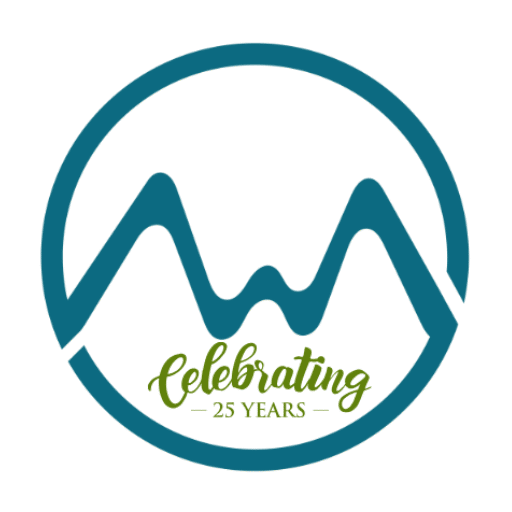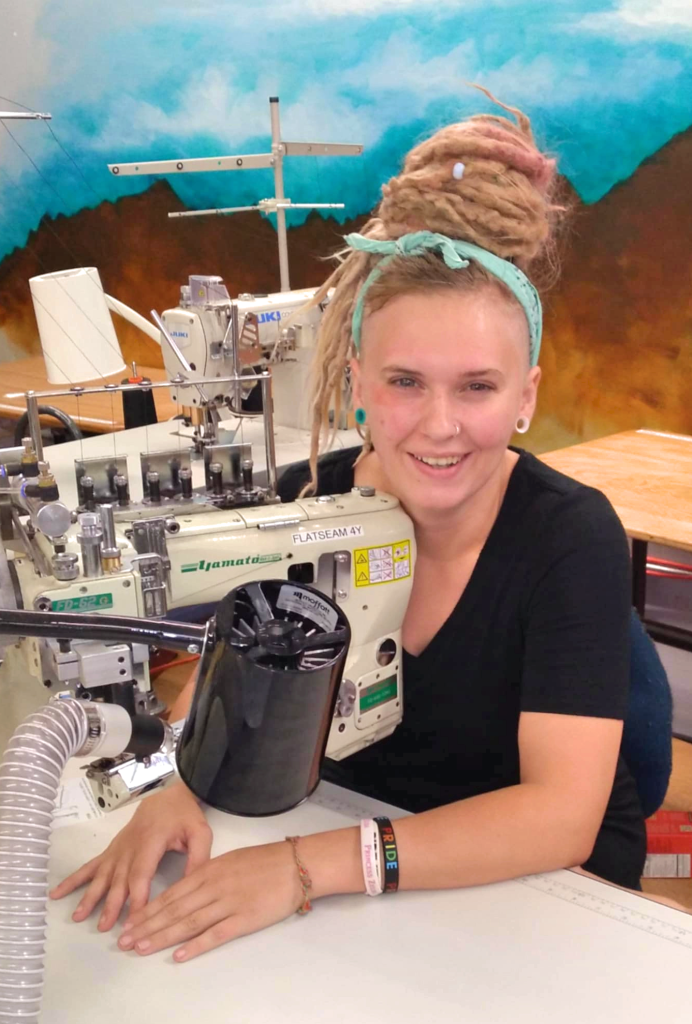What is your current profession?
I’m the Operations Manager for PATTERN.
Would you mind explaining to our readers what PATTERN is?
PATTERN is in development but is going to be a cut and sew manufacturing and industrial sewing training facility in Beckley, WV, set to open in late Summer. We’re working to build a textile industry in southern West Virginia and expand it into other parts of the state as well.
Can you describe the professional journey that led you to your current role as the Operations Manager for PATTERN?
My career path was a really squiggly line! I’ll tell you that. My Granny Norma taught me how to sew on a sewing machine when I was five years old, so it’s something I’ve always done. I’ve always had a passion for crafts, from crocheting to knitting. I have tried my hand at a little bit of everything.
As far as jobs go, I’ve worked at K-Mart, Kroger, McDonald’s, and Wendy’s. I’ve done landscaping. I’ve been a janitor. You name it. Eventually, I became an instructor teaching snowboarding, skiing, and skateboarding. Outdoor recreational and extreme sports coaching took me to Colorado, where I continued to work in that field. It’s hard to survive in Colorado during the mud season because it’s very expensive to live there, so I was working at a retail job to make ends meet.
On my way home from my retail job, I saw a building with women inside who were on sewing machines, and I said, “I’m going to work there.” I decided to really assert myself when I spoke to their management and eventually convinced them to hire me through my persistence. I worked at that business, an outdoor apparel manufacturer called Melanzana, for eight years as a sewing machine operator, and it was a life-changing job. They really took care of me while I went through some of the hardest parts of my life, like the birth of my daughter, as well as my divorce.
Eventually, they decided to open a second facility, and I was one of only two people who decided to move to the new facility two hours away. That’s how I was thrown into management, and I mean thrown in head first. Once I started my role at the new facility, I was doing interviews, sew tests, calling references, making schedules, and hiring people. It was exciting because it was kind of a whirlwind to go from just putting on my headphones while I sewed all day to being launched into management.
I did that for about a year, and then my divorce happened. My ex-husband wanted to move back to West Virginia to be with our family, and I decided it was time for me to come back too. I started messaging places in West Virginia to find work in the textile manufacturing industry because sewing is my passion. I found Edgington Studio in Wheeling, which was four hours away, and I sent a message to the owner, Emily Rouse, saying I wanted to work there and didn’t care how far away it was. Emily replied and asked where I wanted to work, and I said I’d really like to stay in Beckley. She said her company was working with a project in Beckley, and they needed an operations manager! So, here I am, thanks to a crazy coincidence.
I like how you took the initiative to reach out to people and find the job you want. A lot of women don’t know they can do their own networking. They should know they don’t need permission to make a phone call or send an email and ask for what they want.
I’ve always said I push my way into things, and I say I’m already doing things before I get to do them. For example, I was telling people for six months that I was going to work for Melanzana before they even knew my name.
I did the same thing with my new job at PATTERN. I told everyone in Colorado, “I’m going to open a cut and sew manufacturing facility in West Virginia.” That’s what I said I would do, and sure enough, it worked out.
Was there ever anyone who tried to deter you from this career path?
Yes, I was working at a retail store before I was hired at Melanzana, and one of my coworkers said, “You don’t want to work at that place because they go out of business during certain seasons. They’re really picky, and if you make a hoodie wrong, they’ll throw it away.” However, I really didn’t care what she had to say. The position at Melanzana paid a dollar more per hour than the retail job, so I decided to work there anyway. I wanted it, so I did it.
Melanzana paid by piece-rate when I started. At first, I was making $12.00 an hour, but my pay went up based on my production. Within three months, I made $17.00 an hour, and then, in another three months, I was making $21.00 an hour. After another three months, I was at $27.00, and it just kept going up until I plateaued at $30.00 an hour. That was my production value based on how fast I could sew. It was amazing to me that I could give myself these raises.
So, if I had listened to that coworker at the retail store and never started working at Melanzana, I wouldn’t have realized my potential as a production sewer. It was all based on me and what I could do, and I really pushed myself. I found out I was pregnant three months after I had started there, and I decided I wanted to buckle down and make money to take care of my kid. I just pushed and pushed and got better until I was earning the pay rate that I liked.
What opportunities will be available to employees working at PATTERN, and what can you tell me about the training you’ll offer?
We want to be a manufacturing center that also trains people, not just for our facility but for other employers in our area as well. Our goal is to be accessible both financially and geographically, so it’s as easy as possible for people to come here for training.
Maybe they want to relocate, and we have an employer in their area that we’ve already vetted, so we can help them train with us before helping them with their transition to another facility. Alternatively, they could stay and work with PATTERN.
Of course, our team would be small in the beginning and focused on sewing, but the training facility is what we’re really pushing because we want to prepare people for this career. A lack of skilled labor is one of the biggest problems in the field right now. That was a challenge for Melanzana when I worked there, and it’s a complaint we often hear from other employers in this industry, so we need to get people in training.
How long will the training program be? How much will it cost?
We are definitely deep in that discussion at this phase. It really is a social enterprise, so we’re trying to make it affordable, and we’re trying to make the class scheduling as accessible as possible.
For example, maybe some of our local tourism workforce—let’s use raft guides as an example—are only available for training a few weeks at a time. We want to work with that.
Then there are single moms with different scheduling needs. Perhaps they can only attend training in the evenings or on weekends.
So, right now, we plan to have a bootcamp-style class that runs for 6 weeks, and we also want to schedule evening and weekend classes that will run for 10 weeks.
As far as cost goes, we’re not 100% on a number right now, but our main goal is to make it as affordable as possible. We are also hoping to find partnerships to help with fundraising or receive a grant to support students who require a little help financing their training.
What types of job opportunities will be available once PATTERN grows?
Obviously, we will have people working as sewing machine operators. One day, we might have dedicated cutters who will cut out pieces, print patterns, and roll out fabric. More opportunities could arise as we expand.
We might hire a full-time mechanic to service the machines eventually. I’m trained in the mechanical aspect as well, so I’ll do as much of that work as I can until we need to hire somebody to take over that role. Sewing machine maintenance is a very specialized career path. I’ve seen people go from never touching a sewing machine to becoming sewing machine mechanics. It’s something that could develop as we progress.
How can job seekers prepare for a career in sewing machine maintenance?
My mechanic at Melanzana came from a GE factory where he was a parts manufacturer, and I worked with another gentleman who was a car mechanic, so that type of experience feeds into this kind of role. They just need to have the mindset of a mechanic.
What advice do you have for other women who might want to follow in your footsteps?
Just keep being assertive until you get the work you want. I’ve always been so determined for the things that I really want, and just keep saying that I’m doing it. I feel like I manifest my opportunities.
Is there anything else you’d like to share with our readers?
Since this interview is with WV Women Work, I want to take the opportunity to say this is the first career I’ve had where I feel like I have a sisterhood of women. There are men who work in these facilities of course, but it really is so nice to work in an industry that is fueled by women.
Interview conducted, transcribed, and written by Marlynda Arnett, Program Innovation Leader for West Virginia Women Work.

